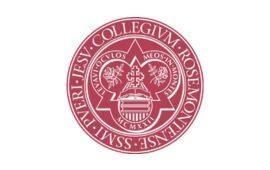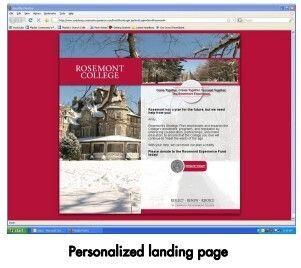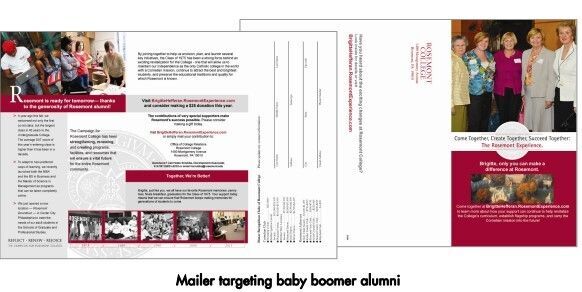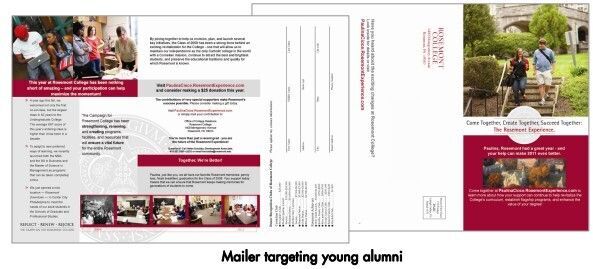Project: Rosemont College Boosts Donor Participation with Data Analytics and Cross-Channel Relevant Marketing
Vertical Market: Education
Business Application: Direct Marketing/Direct Order - Fundraising
Business Objectives
Rosemont College is a private liberal arts college located in Philadelphia, PA with an enrollment of approximately 900 students. They had previously achieved outstanding results with personalized direct marketing campaigns. Through the use of data analytics and enhanced relevant marketing, Rosemont College hopes to improve results for its Annual Fund drive. Objectives for the campaign were:
- Improve overall participation of alumni in annual fund drive
- Grow the stewardship program
- Convert more non-donors into donors
- Improve participation rate by LYBUNT and SYBUNT groups
- LYBUNT (pronounced "lie-bunt"): donors who have given Last Year But Unfortunately Not This current calendar/fiscal year
- SYBUNT (pronounced "sigh-bunt"): donors who have given Some Year But Unfortunately Not This current calendar/fiscal year
- Grow online donations
- Continue to make preparation for public phase of Comprehensive Campaign
Campaign Architecture
Rosemont College is in the midst of a Comprehensive Campaign that requires all Annual Fund efforts to be seamlessly integrated into the $40 million Comprehensive Campaign program. This made the segmentation of the program much more complex.
In the campaign, Rosemont College integrated the following elements:
- Variable direct mail based on giving status, level of previous gift, time of previous gift, relationship to the College (alumni, parents/friends, campaign prospect, etc.) and age
- Variable emails that corresponded with direct mail pieces
- Personalized URLs to continue capturing data to be utilized through the year and lay the groundwork for the launch of the public phase of the Comprehensive Campaign
- Facebook to push online donations
- Variable campaign-related Annual Fund videos synchronized to variable direct mail pieces and emails that pushed online donations
- Timely non-solicitation emails were utilized to engage non-responders, showcase Rosemont's campus and create a sense of good-will among recipients
It was imperative for Rosemont to lay the groundwork for the Campaign by doing donor and prospect research, identifying major donor prospects and capturing pledges. A five-phase campaign was developed that integrated with preparations for a Comprehensive Campaign being officially launched the following year. Previous campaigns had only incorporated four phases. The first phase was launched in August two years prior with subsequent phases following approximately every two months.
Phase One
Over the past two years, Rosemont College's email database and online engagement of alumni grew exponentially as a result of direct marketing campaigns. This allowed an additional phase to be added to the program without substantially increasing the cost - resulting in an extremely high ROI for the program.
Phase One was used to bump up the stewardship program by thanking previous donors, determining why lapsed donors did not make a gift and beginning to identify key prospects for the Campaign. Highlights from campus accomplishments and objectives of the Campaign were prominently explained in emails and personalized landing pages. This showed the progress made by the College and laid the groundwork for the objectives of the Strategic Plan which still needed to be completed. Lapsed donors were asked to provide feedback on why they did not make a donation. If the reason was due to a disagreement with the College’s strategic direction these concerns could be addressed in subsequent communications
Phases Two-Five
Phases Two through Five focused on specific initiative within the Campaign and why support was critical. Past gift dates were utilized to determine when a “harder ask” should be made. The suggested donation amounts also varied based upon previous gifts.
Traditional solicitations have the donor’s last gift amount as the middle option on variable response card or online giving page. To help Rosemont boost gift amounts, the donor’s last gift amount was given as the first option. Industry research has proven that donors will typically give the middle amount, and this proved to be the case for Rosemont as well. 31% of Rosemont’s past donors increased their gift amount that year (almost a 7% increase over the previous year) and 56% gave what they had given in previous years (a 55% increase over the previous year).
By analyzing donor data and giving behavior, campaign costs were reduced by not soliciting all prospective donors during each Phase. ROI was maximized by adjusting the suggested donation amounts. With the consistency in tactics over the past three years, Rosemont was able to re more heavily on email which cut down on production costs and allowed them to put funds towards other outreach efforts like solicitation videos. Rosemont averaged a 22% open rate on email solicitations. According to MailChimp industry benchmarks, this is 32.5% better than the average campaign.
Experience Fund solicitation videos were created and introduced in the spring phases to showcase the need for financial support in an animated way. Videos were developed for two different audiences - young alumni and the rest of the solicitation pool. The videos were connected to social media elements as well as the online giving page. All direct mail pieces and email solicitations were aimed at getting prospect to a personalized landing page to view the video and make a gift.
The messaging of the video was as follows:
- Young alumni
- Make a gift of any amount and see the impact it can have
- Increase Rosemont's national ranking
- Improve the value of your degree
- Remaining prospects
- Showcase the success of the Comprehensive Campaign thus far
- Highlight areas of the Campaign that still need to be finished
As a final push - all recipients received a personalized letter from the President of the College asking them to take action. The variable action item was based upon donor history, past gift amount and relationship to the college. All pieces of the program were tied into the Comprehensive Campaign and were seamlessly integrated throughout the duration of the campaign.
A more elaborate stewardship track was introduced into the Annual Fund efforts. To prepare for the next year and hopefully prevent high donor attrition, quarterly emails were sent to all previous donors to once again thank them for their gift and showcase their gift in action. This was aimed at continuing to make them feel good about their decision and showcase positive outcomes.

Results
- Overall alumni participation increased by 9.6% over a year
- Traditional undergraduate alumni participation increased by 66% over a year (this is a key component of any school's participation rate)
- Non-traditional undergraduate alumni participation increased by 30% over a year
- 31% of Rosemont's past donors increased their gift amount (almost a 7% increase over the previous year) and 56% gave what they had given in previous years (a 55% increase over a year)
- ROI: 1295.65%; Cost to raise $1: $0.07
- Non-donor participation increased by 59% over a year
- Lapsed donor (SYBUNT) participation increased by 275% over a year
- Last year donor (LYBUNT) participation increased by 91% over a year
- While most donations continue to come in via mail, Rosemont did see an increase in online donations



Target Audience & Messaging
Rosemont’s target audience was divided into several segments to drive personalization and ensure that communications were relevant for recipients. Segments were based on the following:
- Donor status (LYBUNT, SYBUNT, non-donor)
- College relationship (traditional undergraduate, non-traditional undergraduate, parents of current students, parents of former students, friends, campaign prospects)
- Graduation year
- Date of last gift
To develop a highly targeted list, donor analysis was conducted that looked at giving history and the engagement of alumni as measured by connections via Facebook, opened emails, attendance at alumni events and more. A wealth screening analysis was also conducted by an outside company. The messages in each communication phase were designed to incorporate information learned during previous campaigns, enrich ongoing conversations and include a feedback mechanism. Unlike previous years, the emphasis of the message to previous donors was on renewing their gift at the same donation level or greater. Through videos and social media Rosemont could show alumni the changes taking place at the college instead of just telling them about it.
Reasons for Success
Rosemont College's strong relationship with our associated company has led to a continuous and advancing use of relevant marketing powered by digital print.
Best Practices Learned
- Use data analytics to reduce costs and improve response. Through the use of donor analytics Rosemont was able to select a highly targeted group of individuals to approach with this campaign. This reduced the number of mail pieces and increased the likelihood of a favorable response.
- Make it relevant. Throughout this campaign Rosemont strove to make communications meaningful for recipients. By segmenting the target audience, images and copy could be varied to have the most impact on the individual.
- Nurture donors. After a gift is made it is important to thank the donor and also continue the engagement through ongoing communications.
